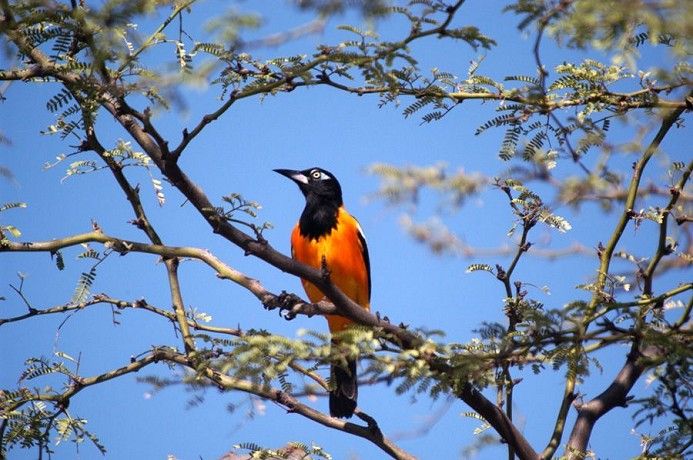|
Troupial Icterus icterus Turpial
|
 |
|
Photo: B. Hallett*
|
|
Troupial Icterus icterus Turpial
|
 |
|
Photo: B. Hallett*
|
|
IDENTIFICATION: The Troupial is bright yellow orange, with a black tail, head and breast. The margin between the black breast and orange undersides is ragged. The wings are black, with a large white patch. At close range, the bright blue skin around the eye can be seen. Immature birds are more yellowish. Length: 25 cm.; weight: 72 g. VOICE: The male and less commonly the female sings a whistled, variable, series of two or three note phrases; sometimes birds duet. Audio 2 (M. Oberle). HABITAT: Dry deciduous forest, thorn scrub, open wooded country, palm groves, and suburban gardens. HABITS: The Troupial often travels in pairs, or small family groups feeding on fruits of royal palm, sebucán (Cephalocereus), and other plants. In the breeding season it increases the proportion of protein in its diet by eating more insects, birds eggs and nestlings. Despite the fact that the Puerto Rican population probably originated from escaped or released caged birds, the Troupial is wary of humans and typically does not allow close approach except when habituated to bird feeders. It builds a nest in cactus, thorny bush or tree (and sometimes in cavities such as in buildings), chiefly in April and May. The female lays 2-4 spotted eggs and incubates the eggs for 15-16 days. Both parents feed the nestlings until they fledge about 21-23 days after hatching. In its native South America, Troupials often take over and use abandoned nests of other bird species. STATUS AND CONSERVATION: The Troupial was probably introduced from South America, and has been reported in Puerto Rico since 1810. It is currently common, but was often captured for sale as a cage bird until the trade in wild birds was regulated. The Shiny Cowbird sometimes lays its eggs in Troupial nests. RANGE: Native to the Amazon basin, and through most of northeastern Colombia and Venezuela (where it is the national bird). It has been introduced to a number of Caribbean islands. The Troupial is most common in southwestern Puerto Rico. A typical site to find this bird is on the trails at the eastern end of PR 333 in Guánica State Forest. TAXONOMY: PASSERIFORMES; ICTERIDAE; There are three subspecies, the one introduced to Puerto Rico (Icterus icterus ridgwayi) has a large white wing patch, as opposed to a smaller, divided wing patch on the other common subspecies in Venezuela. |
 |
|
Photo: A. Sánchez Muñoz
|
 |
|
Photo: A. Iñigo
|
 |
|
Photo: B. Hallett*
|
|
References Camacho Rodríguez, M., J. Chabert Llompart, and M. López Flores. 1999. Guía para la identificación de las aves exóticas establecidas en Puerto Rico. Depto. de Recursos Naturales y Ambientales, San Juan, PR. Jaramillo A. and P. Burke. 1999. New World Blackbirds: The Icterids. Princeton Univ Press. Lindell, C. and C. Bosque. 1999. Notes on the breeding and roosting biology of Troupials (Icterus icterus) in Venezuela. Orn. Neotrop. 10:85-90. Orians, G. 1985. Blackbirds of the Americas. Univ. of Washington Press, Seattle, WA. Post, W. 1981. Biology of the Yellow-shouldered Blackbird (Agelaius xanthomus) on a tropical island. Bull. of the Florida State Museum Biol. Sci. 26:125-202. Raffaele, H.A. 1989. A guide to the birds of Puerto Rico and the Virgin Islands. Princeton. Raffaele, H.A. 1989. Una guía a las aves de Puerto Rico y las Islas Vírgenes. Publishing Resources, Inc., Santurce, PR. Raffaele, H.A., J.W. Wiley, O.H. Garrido, A.R. Keith, and J.I. Raffaele. 1998. Guide to the birds of the West Indies. Princeton. Ridgely, R.S. and Tudor, G. 1989. The birds of South America: the oscine passerines. Univ. Texas Press, Austin. Next related species in taxonomic order Previous related species in taxonomic order |